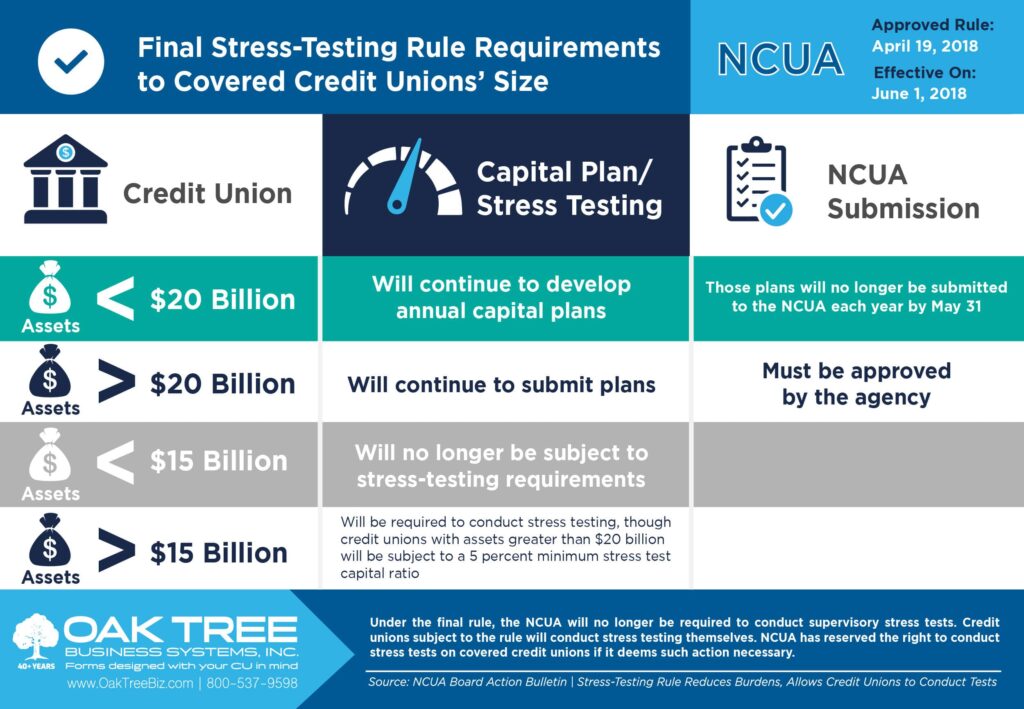
Credit Unions and Stress Testing
While there is controversy surrounding stress testing, it is essential to note that credit unions are just as much at risk as big banks. Trouble can come in multiple forms, and if credit unions don’t adapt, they can easily succumb to branch closings or company failure, both of which point back to strategic risk. We will take a quick look at how your credit union can continue staying ahead of the game when it comes to stress testing and a little on how AI can assist.
The following actions should be considered to adequately prepare your credit union for stress testing.
- Stress testing is more than a regulatory requirement. Credit unions can benefit from the closer relationship between senior management and the board by treating stress testing as an opportunity to improve processes and focusing less on cost and time.
- Don’t get overwhelmed. Implementing a comprehensive stress-testing program in the first year is unreasonable. Start by accessing individual goals and building a framework. Make a five-year plan and continue implementing deeper testing each year to minimize risk.
- Simplify legacy IT systems. If you have multiple legacy IT systems in place, you will need to consider how this will affect your stress test results. Data challenges must be addressed before a proper policy can be put into place.
- Incorporate a board-approved policy. Stress testing is a comprehensive process that can be customized to your credit union. Get a policy approved that will guide the testing for years to come. Once you have the process complete, you can easily reference the approved policy for efficiency.
- Take action on stress test results. A stress test is pointless if you don’t learn from the results. Once a stress test has been completed, a meeting with the board and management can solidify any changes or improvements going forward.
How to tackle the competition
Let’s talk about demographics first. Your field of membership and asset size will determine who your competition might be. Even though your credit union may not be required to run a stress test, it is beneficial for your credit union growth. The final stress-testing rule was made effective June 1, 2018, and according to NCUA, the final rule may be more efficient by authorizing covered credit unions to conduct their stress tests per the NCUA’s requirements and permitting covered credit unions to incorporate the stress test results into their capital plans.
By incorporating technology resources as budget allows and offering superior member service, credit unions can remain competitive and increase market share. To complete the test, your credit union would run what-if scenarios to determine if you have sufficient assets to survive periods of economic stress. Credit unions are unique in the data they collect compared with similar financial institutions. They now have access to affordable artificial intelligence and software to dominate the small loan sector.
AI is part of our everyday lives whether we realize it or not. We use AI to choose a Netflix movie, find the best route home from work, and whenever we summon Google, Siri, or Alexa. This technology is growing fast with Google now releasing Bard for public consumption and testing alongside ChatGPT both gaining a lot of action on the internet. Once thought to be only accessible by big banks in the financial sector, AI is now affordable for credit unions, and it can help with day-to-day operations, employee retention, and member relationships. Performing stress tests with AI speeds up your stress test exercise. AI enhances the credit union experience in three main ways: by interpreting customer behaviors, improving customer service, and offering competitive loan rates.
Interpreting member behaviors & improving member service
Credit unions market themselves as financial institutions that will provide consumers with personalized service. They offer services that big banks run from, such as small personal loans and free ATMs. While credit unions already have a variety of member data collected, they often don’t know how to leverage this data to stand out in a highly competitive market. Fortunately, AI can bridge the gap. By combining existing member data with AI technologies, credit unions can take their personalized customer service to the next level. Track which financial education resources your member uses to offer them a mortgage or a secured credit card. You can even send them competitive loan rates if your member searches for auto loan options through your website or a mobile app.
Chatbots are also an essential part of engaging your members. Members have come to expect an answer from Google, Siri, and Alexa in less than a second. These will only improve with the progress of other natural language processing systems. If your credit union information such as branch hours, loan applications, and current rates or promotions are not instantly available, potential members are likely to sign up with a financial institution that has implemented the technology.
Integrated chatbots on your website and mobile app can provide instant access to common questions, 24/7. Without additional personnel, you can help your members take advantage of relevant services and increase their financial confidence with real-time information.
Offering competitive loan rates
AI lending platforms are helping credit unions scoop up small loans that big banks are missing. This focus on smaller loans allows credit unions the opportunity to swoop in and provide small business and personal loans that can be highly profitable. A test for possible loss of portfolio growth and measuring the expected effects on your credit union portfolio can be key for loan rate changes.
Online or in-person applications can quickly be completed by asking the member a series of questions. By gathering this data, you can personalize the experience and collect data on the process by which the member requests the loan amounts needed and make an intimidating loan process friendly. While big banks may have access to this technology, they can’t extend the personalized service and follow-up that a credit union can easily provide.
Benefits of automation
Just as credit unions can benefit from integrating AI to improve member relationships, they can also use stress testing software to automate risk management and proactively manage ever-changing requirements. With Tier II and Tier III credit unions (between $15 billion and $20 billion, and over $20 billion in assets, respectively) allowed to conduct their stress tests, utilizing automation can reduce costs and improve productivity.
Stress testing software can:
- Simplify your reporting
- Identify potential volatility
- Increase informed decision-making regarding lending and branch planning
- Satisfy examiners
You can stay ahead of the game by continuing to implement small changes that make a big impact. Your credit union stress test exercise would benefit your senior-level staff and help to understand your credit union’s financial strength, so why not keep a clear vision and prevent a possible loss of growth? Leverage your potential and existing members by understanding their specific needs and determining the best way to engage with them.
Consider big banking features that your members would benefit from, invest in AI, invest in proper lending documents, and improve your overall business plan by focusing on a personalized stress test.



